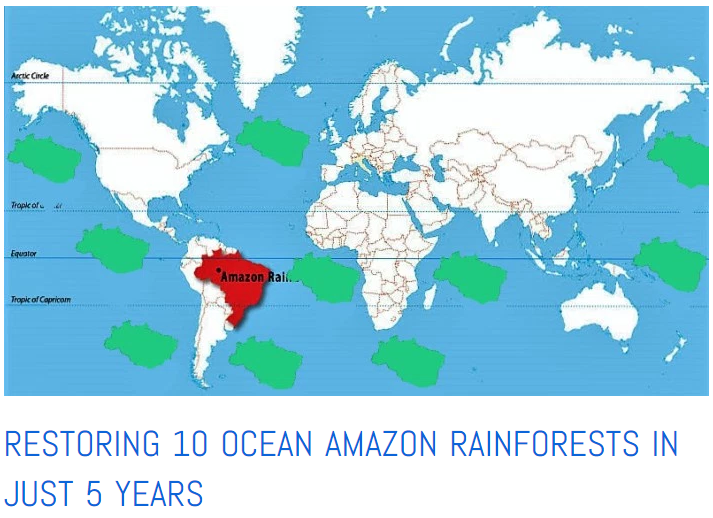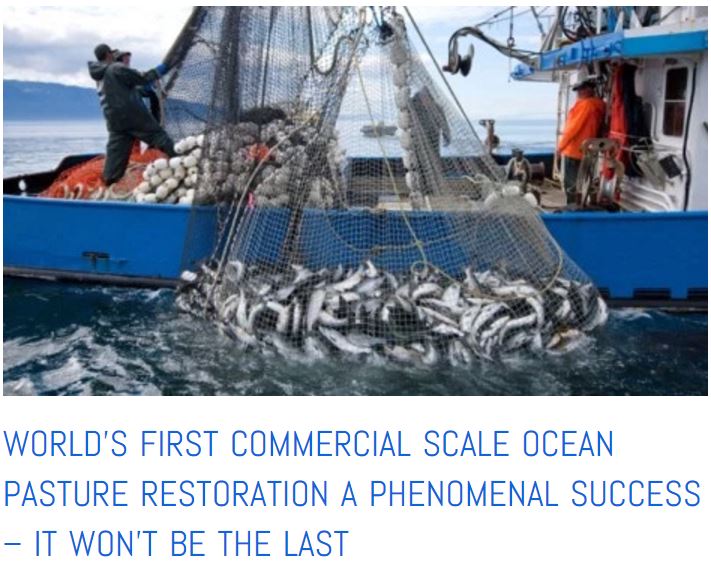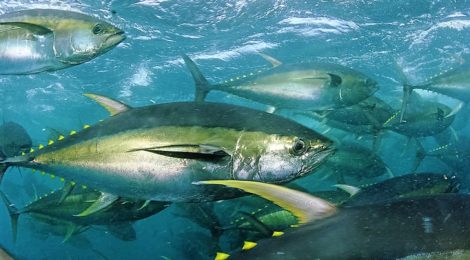
Ocean CO2 Burns And Blinds Eyes Of Baby Tuna – Help On The Way
Already the nearly trillion tonnes of CO2 humanity has added to our air and oceans has decimated ocean plant and marine life
Now new studies portend a worsening CO2 calamity as the tiny larvae of ocean fish like Yellowfin Tuna are soon to be finding their eyes burned and scalded in oceans of acid
But all is not lost for the tuna or us, by restoring ocean pasture plant life regenerated ocean phytoplankton will readily repurpose our acid making CO2 into new ocean life – saving not only the eyes of baby tuna but all life on this blue planet
This post offers a view of a newly published study in the Journal of Experimental Marine Biology and Ecology, on the direct effects of our high and rising carbon dioxide (CO2) in the ocean that is rapidly changing the acidity of the oceans that present day life has evolved to live in. The rate of ocean acidification is 10,000’s of times faster than evolution which might otherwise help existing ocean life adapt during the normal slow plodding change that takes place over eons of time. This is especially true for the larger forms of ocean life-like Yellowfin tuna whose species are now in mortal danger.
What the boffins who conducted scalding experiments in the laboratory on baby tuna neglected to mention is that there is work that we can and must do immediately to offer the tuna our help.
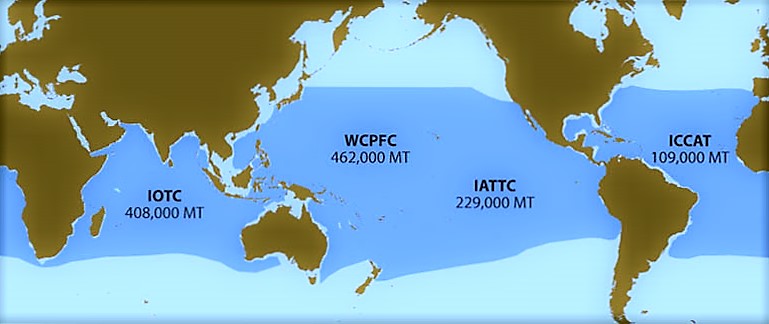
Yellowfin Tuna Regions, tonnes taken each year, management regimes.
The new laboratory report focuses on the Yellowfin Tuna which is one of the most widely ranging tuna on our blue planet. They are stunningly beautiful fish with dark metallic blue backs, yellow sides and fins, and a bright silver belly. The average age of Yellowfin is about 8 years but often in the past they lived several times longer. They have a habit of being both very locally resident and very migratory are found throughout the Pacific, Atlantic and Indian Oceans in warmer sub-tropical and tropical regions.
The lives and fate of the Yellowfin, now that the larger more desirable Bluefin Tuna are all but gone, less than 3% remain, is subject to increasingly ruthless fishing pressure. But far worse than overfishing is the fact that their ocean pastures that historically sustained all of ocean life have been decimated and many times over. The ocean pastures of the Yellowfin around the world have been observed to have lost 25%-50$ of their primary productivity since the first ocean observing satellites were launched in the early 1980’s.
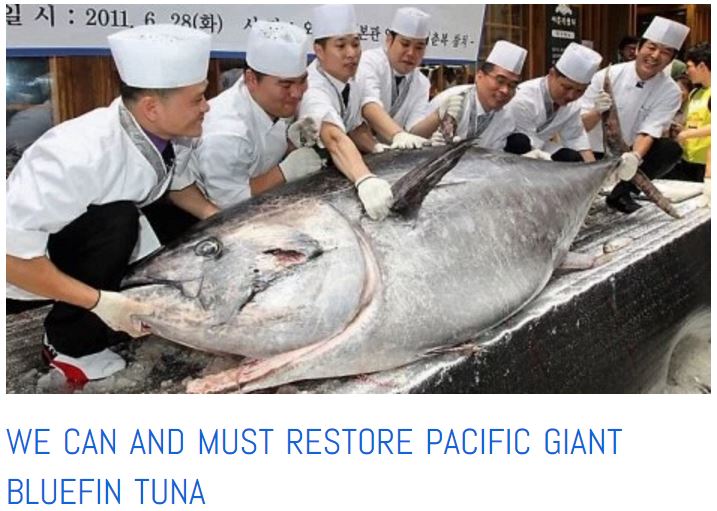
Giant Bluefin Tuna down to less than 3% of their former abundance can and MUST be restored – click to read more
The Bluefin being the largest of the great beasts of ocean pastures has been first to succumb to being starved into near extinction while the remaining few have been relentlessly overfished.
Think of the tuna like you might of the similar tragedy of the American Buffalo once in uncountable numbers on the great plains. As civilizations farms and ranches forced the buffalo onto dwindling wild pastures the Buffalo hunters went wild and delivered the final death blow driving them nigh unto extinction.
It is estimated that 90 percent of all large predatory fish
including tuna, sharks, swordfish, cod and halibut
are all now gone.
In this new study, researchers from the University of California at Santa Barbara, the Inter-American Tropical Tuna Commission and a few other organizations gathered baby Yellowfin from a commercial aquaculture broodstock which is normally exposed to a very moderated seawater pH (acidity) level between 8.27 and 7.74. The larvae in the lab were exposed to waters with four different levels of carbon dioxide, which changed the pH from a bit higher to much lower.
One first tank serving as a control was maintained with a pH of 8.1.
A second ‘torture chamber’ had a pH of 7.6, which matches global warming projections for the year 2100.
A the third ‘chamber of horrors’ had a pH of 7.3, matching projections for the year 2300.
The last ‘hellish dungeon’ had a pH level of 6.9 that was considered the “lowest projection for the Pacific Ocean” during the course of the fossil fuel age.
All of that scalding acid added up. The researchers found that it caused damage to the liver, kidney, pancreas, muscle tissue and eyes of the vulnerable baby Yellowfin larvae—all within a week of exposure. Their growth rates also suffered, ranging from 20 to 41 percent
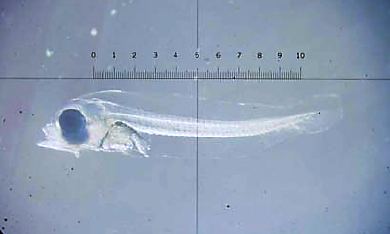
This 6 day old Yellowfin baby, barely a cm long, needs her big eyes to be in perfect condition to find plankton food and avoid predators looking to eat her.
The effects on the tiny vulnerable larval tuna was horrific as one might expect from such a vital but ghoulish experiment. The acid seawater burned the eyes of the baby tuna – and alone, without considering other compounding effects, led to a mortality rate of between 50 and 100 percent.
Those few that survived the first eye-burning agony suffered critical poisoning of their kidneys and other organs which would create all manner of life threatening complications as they grew resulting in even higher mortality rates.
Yesterday’s CO2 Already Emitted Will Continue To Acidify Our Oceans For A Ccntury To Come – Tomorrow’s CO2 That Which We Will Surely Emit During The Course Of The Rest Of Our Fossil Fuel Age Will Make The Oceans Uninhabitable For Tuna And Countless Forms Of Marine Life.
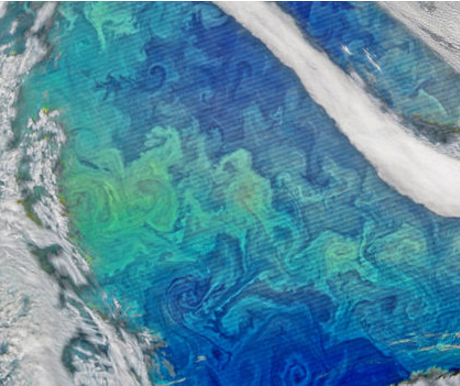
Plankton blooms are the most powerful force of Nature on our blue planet. They have the capacity, if restored to former health and abundance, to safely and sustainably manage humanity’s excesses of CO2 while simultaneously restoring tuna to historic abundance. Click to read more
CO2 is perfectly soluble in water, and as such on this blue water planet of ours the final destiny of almost all CO2 is to be dissolved in the oceans that cover 72% of our water world. When water meets CO2 it becomes acid, that’s the most simple of all chemical facts. H2O+CO2=H2CO3 ‘Carbonic Acid.’
The only significant force that changes the destiny of CO2 from becoming acid is the most powerful force of Nature ocean photosynthesis by the phytoplankton, the ‘grass’ of the ocean pastures.
Ocean pasture photosynthesis prior to the fossil fuel age had the capacity and indeed did repurpose nearly 100 billion tonnes of CO2 into new ocean life, plankton, every year. Humanities emissions of CO2 has overloaded the natural system resulting in about a 10 billion tonne per year accumulation of extra CO2 in the air, heading to the oceans to become, as this masterful though horrifying experimental paper has proven eye scalding ocean acidification for baby tuna and immeasurable and vital forms of tiny ocean life.
Our Powerful CO2 Feedback Effect
Why humanities relatively small perturbation of the CO2 balance in Nature is having such a cataclysmic effect is that our high and rising CO2 is feeding and nourishing plant life on land. All over the world there is a dramatic ‘global greening’ effect taking place. The CO2 is feeding plants on land which you might think is a good tipping of the balance of Nature.

Geophysical Review Journal reports rising atmospheric carbon dioxide levels are producing a global greening of terrestrial plant life around the world while eradicating ocean plants. – click to read more
Alas more greenery on the earth is the worst possible news for the oceans. More grass growing means less dust blowing.
All plants whether growing on land or in the ocean have just two most critical requirements, they need minerals, and they need water. This is where the world of plants on our blue planet splits in two.
The plants on land have all of the minerals they need, they are stuck in it, in the dirt. The plants in the oceans have all of the water they need, they are stuck in it, in the water.
The work reported in this recent GRL publication provides extensive satellite data corroborated with land based measurements that show rising CO2 levels caused a remarkable 11 percent increase in foliage in arid regions in just 30 years as compared to what might have been the case if atmospheric carbon dioxide levels had remained at 1982 levels.
Collapse of ocean plant-life is proving devastating but also immediately able to be restored and regenerate for the benefit of ocean life and life on earth as well.
Here’s my prescription.
This will bring the ocean fish pastures to historic health and abundance.
IT JUST WORKS!









